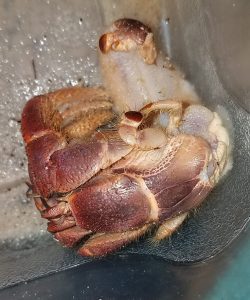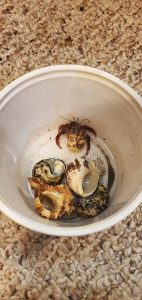
A hermit crabs shell serves two purposes: first protection of the soft abdomen and second it prevents desiccation (drying out). A hermit crab that has left the protection and life-sustaining seashell home is telling you it’s in distress.
- Physically stressed from poor handling or conditions during capture, transport and/or poor pet store conditions
- Shell fight-another hermit crab has taken its shell-no suitable shell remains
- Changing shells and let go of the old one, which was shell-napped by another crab-no suitable shell remains
- Foreign body/irritant in the shell (sand, pest, fungus NOTE: crabs have been known to hide food in their shell)
- Temperature is too HIGH
- Humidity is off
- Pre-molting, although it rarely happens
Below we expand a bit on these causes.
Physical Stress
Land Hermit Crabs endure a great amount of stress before reaching the pet store. The harvesting and shipping of hermit crabs is a very inhumane process and the crabs suffer because of it. They then arrive in pet stores, who in most cases, don’t know how to properly care for them. They arrived stressed out, dehydrated and hungry. Then you purchase them and take them home. Now severely physically damaged the hermit crab will often leave its shell to die.
Shell Fight
If there is not a variety of appropriate styles and sizes of extra changing shells in the crabitat for the hermit crab to choose from, there may also be shell fights. This is normally dangerous for the hermit crabs within the crabitat due to the fact that hermit crabs would rather let themselves be pulled apart as opposed to giving up their protective home. Many times this leads to a hermit crab being seriously injured or even killed by the aggressive hermit crab in search of a comfortable shell.
There are times too when a hermit crab is shell shopping and may of let go of his original shell to try another on and has his shell taken by another tank mate. This forces the hermit crab to find another shell, if a suitable one isn’t available it is left homeless.
Foreign body
Something may have got into his shell and is irritating his soft abdomen. One can rinse the shell out with dechlorinated water, but many times if something is lodged within the shell this doesn’t help much. Boiling the shell in dechlorinated water and giving it a good shake will many times dislodge anything that may be within it. There maybe pests or a fungus within the shell that is irritating his abdomen and will cause him to leave the shell.
Incorrect environment – too hot, too much or too little humidity
If the hermit crab is too warm, to try to cool off a hermit crab will leave their shells. To prevent over heating it is very important to monitor the substrate temperature as well as the air temperature. The temperature at the warm end of the crabitat should be approximately 80-82F. At 85F or higher this is nearing too warm for most hermit crabs to be comfortable (some species do enjoy higher temperatures). The temperature at the cool end of the crabitat should be approximately 72-75F. Hermit crabs are ectothermic creatures and must have the variance of temperatures to self regulate.
If the humidity level is too low in the crabitat hermit crabs feel as though they are suffocating. In hopes of relieving the discomfort they are experiencing they leave their shells. If they had been subjected to a too low humidity, too many times it has already caused irreversible gill damage. For a more accurate humidity percentage reading level, the humidity gauge should be located close to substrate in the middle of the tank away from water sources that can affect the gauges reading. The safe range is 70-80% relative humidity. Cheap analog gauges from pet stores are rarely accurate.
Please calibrate your humidity gauge to ensure how accurately it is reading:
Calibration
A hermit crab will also leave their shell due to a too high of a humidity percentage. A high humidity level makes it difficult for the hermit crab to breath due to the ‘thicknesses’ of the humidity. If subjected to a too high humidity level, this can promote a gill infection that may cause irreversible damage. Maintaining humidity levels of 90% and higher is discouraged.
And even though it is rare, he maybe in premolt or be molting. Pre molt symptoms
How to gently coax a hermit crab back into their shell
Wash your hands.
For a hermit crab who has gone naked to surface molt or come up from molt naked and still soft please jump down to the NOTE section.
Rinse or boil the shell in dechlorinated water and shake it to remove anything that maybe lodged within it. Pour out most of the water from the shell. Place the shell in the bottom of a cup or small bowl depending on the size of the crab. The container should be JUST big enough for the crab and the abandoned shell. Add a small amount of dechlorinated water the bottom of the cup. This will help keep the crab moist and may help the crab re-shell.
Wash your hands.
If the hermit crab is not in mid molt or still soft from molt, gently pick the hermit crab up by lightly holding it just behind the last pair of walking legs. You can also use a large spoon to scoop him up very gently. Carefully examine the abdomen for any signs of irritation being very careful he does not attempt to escape and injure/kill himself. Examine for any molting symptoms as in transparent eyes, lifting of the old exoskeleton, water sac, etc. Lethargy can be a sign of pre-molt or death.
Lower him into the cup next to his shell. Cover the cup with a washcloth to make it dark. Transfer the cup to an isolation unit where the temperature and humidity are within proper ranges OR back into the main tank. Ensure other crabs in the tank are not able to climb into the cup.
Leave the hermit crab in darkness and quiet for a while, an hour should be enough time, and it may return to the shell.
If the crab is still naked you can move to a slightly larger containment area like a small kritter keeper. Add a few more shells that might fit the naked crab to the kritter keeper. Transfer the naked crab and the original shell to the kritter keeper. Offer somegreensand, worm castings, scrambled eggs or other favorite food to encourage eating. If the crab is extremely lethargic and not eating, try dipping a toothpick in some honey and offer it. Do not force the crab to eat. Sometimes the crab will accept the honey and get a little boost from the sugar. Place the kritter keeper inside of your isolation tank or in the main tank. It is important the hermit crab remain in the correct heat and humidity.
If the crab still will not take a shell there is little else to do but keep him comfortable and wait. Continue to offer food and water, maintain humidity and heat.
Note: Molting or recently molted crabs should be handled differently. If the crab is still soft or molting, use our 2 liter bottle method (cut off the bottom and place over the crab like a dome) to isolate the crab within the tank. Be aware this does not protect from crabs digging in from below so please keep an eye on the crab. If your other crabs seem overly interested you may need to transfer the crab to a secure container within the crabitat. Use a clean glad ware type bowl with a lid. You can poke holes in the lid. Use a clean spoon or similar scoop to gently scoop up the crab by digging slightly into the substrate below him so that the body is still resting on the substrate and not touching the scoop. Gently place in the bowl along with the most recent shell and one or two other options. Do not add water to this bowl because of the soft exoskeleton. The crab is going to be exhausted and likely will be unable to take a shell until it has fully hardened and regained energy. If the shed exo is available be sure to put it in the bowl along with some water and other foods. Our Hermit Crab Feeding Guide can direct you to the most beneficial foods at this time.
If you need any further help, please read the Emergency Help Article.


